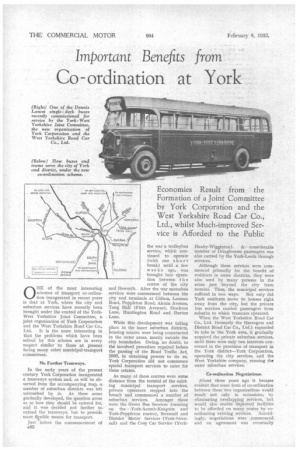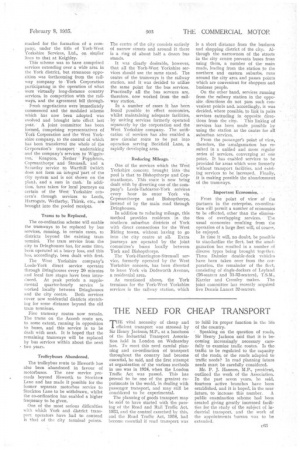Important Benefits from
Page 124

Page 125

If you've noticed an error in this article please click here to report it so we can fix it.
Co-ordination at York
ONE of the most interesting schemes of transport co-ordination inaugurated in recent years is that at York, where the city and suburban services have recently been brought under the control of the YorkWest Yorkshire Joint Committee, a joint organization of York Corporation and the West Yorkshire Road Car Co.,
Ltd. It is the more interesting in that the problems which have been solved by this scheme are in every respect similar to those at present facing many other municipal-transport committees.
No Further Tramways.
In the early years of the present century York Corporation inaugurated a tramways system and, as will be observed from the accompanying map, a number of suburban districts was left untouched by it. As these areas gradually developed, the question arose as to how they should be catered for, and it was decided not further to extend the tramways, but to provide more flexible means for transport.
Just 'before the commencement of c0.1
'71 FULFORD
•
the war a trolleybus service, which continued to operate (with one short break) until a few weeks ago, was brought into operation between tlie centre of the city and Heworth. After the war motorbus services were commenced between the city and terminals at Clifton, Leeman Road, Poppleton Road, Mcuin Avenue, Tang Hall (Fifth Avenue), Stockton Lane, Huntington Road and Burton Lane.
While this development was taking place in the inner suburban districts, housing estates were being constructed in the outer areas, mostly outside the city boundaries. Owing, no doubt, to the involved procedure required before the passing of the Road Traffic Act, 1930, in obtaining powers to do so, York Corporation did not commence special transport services to cater for these estates.
As many of these centres were some distance from the termini of the existing municipal transport services, private operators stepped into the breach and commenced a number of suburban services. Amongst these were the Green Bus Services (running on the.; York-Acomb-Knapton and York-Poppleton routes), Strensall and • District Mot:or Services (York-Strensall) and the Cosy Car Service (York
Haxby-Wiggin ton). A,: considerable number of Dringhouses passengers was also carried by the York-Leeds through services.
Although these services were commenced primarily for the benefit of residents in outer districts, they were also used by many persons in the areas just beyond the city tram termini. Thus, the municipal services suffered in two ways. Not only did York residents move to houses right away from the city, but the private• bus services carried passengers from suburbs to which tramcars operated.
When the West Yorkshire Road Car Co., Ltd. (formerly the Harrogate and District Road Car Co., Ltd.) expanded to take in the York area, it gradually acquired the private suburban services, until there were only two interests concerned in the provision of transport in the York district—York Corporation, operating the city services, and the West Yorkshire company, running the outer suburban services.
Co-ordination Negotiations.
About three years ago it became evident that some form of co-ordination between these two 'organizations would result not only in economies, by eliminating overlapping services, but would also enable improved facilities to be afforded on many routes by co
ordinating existing services. Accordingly, -negotiations were commenced and an agreement was eventually reached for the formation of a company, under the title of York-West Yorkshire Services, Ltd., on similar lines to that at Keighley.
This scheme was to have comprised services extending over a wide area in the York district, but strenuous opposition was forthcoming from the railway company to York Corporation participating in the operation of what were virtually long-distance country services, in competition with the railways, and the agreement fell through.
• Fresh negotiations were immediately commenced and the modified sChertfe which has now been adopted was evolved and brought into effect last year. A joint 'committee has been formed, comprising' representatives of York Corporation and the West Yorkshire company, to the control of which has been transferred we whole of the Cuporation's transport undertaking
• and the company's services to Wigginton, Knaiston, Nether ' Poppleton, Copmanthorpe and Strensall, and 'a Saturday service to Warthill (which
• does not form an integral -part of the city system and is not shown on the plan), and a sum in cash.In 'addition, fares taken. for local journeys on certain of the West. Yorkshire concern's through services to Leeds, Harrogate, Wetherby, Thirsk, etc., are brought into the pooled receipts.
Trams to be Replaced.
The co-ordination scheme will enable the tramways to be replaced by bus services, running, in certain cases, to districts beyond the existing tram termini. The tram service from the city to Dringhouses has, for some time, been operated at a heavy loss, and this has, accordingly, been dealt with first.
The West Yorkshire company's Leeds-York direct service operates through Dringhouses every 20 minutes and local fare stages have been introduced. At peak periods a supplemental quarter-hourly service is worked locally between Dringhouses and the city centre. Both services cover new residential districts stretching for some distance beyond the old tram terminus.
Five tramway routes now remain. The trams on the Acomb route are, to some extent, running in opposition to buses, and this service is to be dealt with next. It is hoped that the remaining tramways will be replaced by bus services within about the next two years.
Trolleybuses Abandoned.
The trolleybus route to Heworth has also been abandoned in favour of motorbuses. The new service proceeds beyond Heworth to Stockton Lane and has made it possible for the former separate motorbus service to Stockton Lane to be withdrawn, whilst the co-ordination has enabled a higher frequency to be given.
One of the most serious difficulties wills which York and district transport operators have had to contend is that of the city terminal points. The centre of the city consists entirely of narrow streets and around it there is a ring of about half a dozen bus stands.
It was clearly desirable, however, that all the York-West Yorkshire services should use the same stand. The centre of the tramways is the railway station, and it was decided to utilize the same point for the bus services. Practically all the bus services are, therefore, now worked from the rail
way station. , In a number of cases it has been found possible to effect economies, whilst maintainingadequate facilities, by uniting services formerly operated separately by the corporation and the West Yorkshire company. The unification of services has also enabled a new circular route to be put into operation serving Beckfield Lane, a 'rapidly developing area.
Reducing Mileage.'' One of the services which the West Yorkshire , concern, brought_ into 'the pool is that to Bishopthorpe and Copmanthorpe. This route is now being dealt with by diverting one of the company's Leeds-Tadcaster-York services every hour to enter York via Copmanthorpe and Bishopthorpe, instead of by the main road through Dringhouses.
In addition to reducing mileage, this method provides residents in the southern suburban districts of York with direct connections for the West Riding towns, without having to go into the city centre at all. Extra journeys are operated by the joint committee's buses locally between York and Bishopthorpe.
The York-Huntington-Strensall service, formerly operated by the West Yorkshire concern, has been diverted to leave York via Dodsworth Avenue, a residential area.
As mentioned above, the York terminus for the York-West Yorkshire services is the railway station, which is a short distance from the business and shopping district of the city. Although the narrowness of the streets in the city centre prevents buses from using them, a number of the main roads, leading from the station to the northern and eastern suburbs, runs around the city area and passes points which are convenient for shoppers and business people.
On the other hand, services running from the railway station in the opposite directions do not pass such convenient points and, accordingly, it was decided, where possible, to link in pairs services extending in opposite directions from the city. This linking of services has been made .pOssible by using the station as the centre for all
suburban services. . • From the passenger's point of view, therefore, the amalgamation has resulted in a unified and more regular series Of services, converging at one point. It has enabled services to be provided for areas which were formerly without transport facilities, and existing services to be increased. Finally, it is making possible the abandonment of the tramways.
Important Economies.
From the point of view of the partners in the enterprise, co-ordinaties will permit a number of economies to be effected, other than the elimination of overlapping services. The usual economies resulting from the operation of a large fleet will, of course, be enjoyed.
In time it will, no doubt, be possible to standardize the fleet, but the amalgamation has resulted in a number of diverse types being brought together. Three Daimler double-deck vehicles have been taken over from the corporation, the remainder of the fleet, consisting of single-deckers of Leyland (26-seaters and 31-32-seaters), T.S.M., Karrier and Crossley makes. The joint committee has recently acquired five Dennis Lancet 32-seaters.














































































































































































